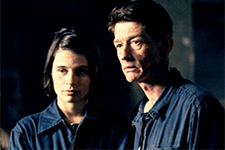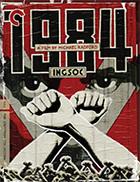1984
|  Writing in The New Yorker in late January 2017, essayist Adam Gopnik confessed that he had never been a big fan of George Orwell’s 1949 dystopian classic 1984, having found it “too brutal, too atavistic, too limited in its imagination of the relation between authoritarian state and helpless citizens.” However, only a week of Donald Trump’s Presidency was enough to change Gopnik’s mind: “Because the single most striking thing about his matchlessly strange first week is how primitive, atavistic, and uncomplicatedly brutal Trump’s brand of authoritarianism is turning out to be. We have to go back to ‘1984’ because, in effect, we have to go back to 1948 to get the flavor.” Not surprisingly, Trump’s shocking election in November 2016 sent Orwell’s novel rocketing up the best-seller lists, as people immediately recognized that the terms Orwell had introduced into political rhetoric—newspeak, Big Brother, doublethink, thoughtcrime—were more real than ever, lending credence to the idea that Orwell’s nightmare vision of a totalitarian future—in which free thought is banished, war is perpetual, and everyday people, fed a nonstop diet of lies, historical revisionism, and propaganda and kept under constant surveillance, have become automatons of the state—wasn’t limited in imagination, but frighteningly prescient. The first week of Trump’s Presidency, after all, introduced the concept of “alternate facts,” the kind of logically contradictory, but politically appealing doublespeak that dominates the rhetoric of Orwell’s novel. So, as Gopnik noted, we have to go back to 1984 because it tells us so much about what is happening now. That also means that we should once again take up Michael Radford’s film adaptation, which was filmed and released in 1984 (it follows several early adaptations, including a 1953 episode of the American TV anthology series Studio One, a 1954 BBC Sunday Night Theatre episode, and a 1956 feature film). Although it received generally good reviews at the time, Radford’s 1984 didn’t perform particularly well at the box office, perhaps because the film industry in the mid-1980s was leaning more and more heavily on conventional, feel-good entertainment, and a dour, dreary, dystopian drama that reaffirms the worst tendencies of human nature and the endless corruptibility of power was simply not in the cards. Radford, who had directed only one feature at that point (1983’s Another Time, Another Place about a Scottish housewife during World War II falling in love with an Italian prisoner of war), stayed largely faithful to Orwell’s novel, which follows the story of Winston Smith (John Hurt), a mid-level bureaucrat in the fictional totalitarian state of Oceania whose job is to change the historical record to keep up with the ever-changing narrative of the ruling Party and its leader, Big Brother. Winston plays the role of the dutiful citizen, but he secretly hates the Party and what it represents, and he resists their control by writing in a diary and engaging in intellectual curiosity. His primary rebellion, though, comes in the form of a sexual relationship with a fellow worker named Julia (Suzanna Hamilton). Theirs is a relationship initially forged out of simple, physical desire interlaced with a shared hatred of the powers that be, but it grows into something that looks a lot like hope. Of course, all hope is to be crushed in Orwell’s nightmare vision of the future, in which everything—from exercise, to information, to razor blades and chocolate—is strictly controlled by those in charge. When he was writing the novel in 1947 and 1948 under great physical duress from his tubercular condition, Orwell was concerned about the postwar state of Britain. Having witnessed fascism overtake Germany and Italy and Stalinism destroy the last vestiges of true socialism in the Soviet Union, he rightly recognized how little it takes to push a country over the brink. Watching Radford’s mid-1980s adaptation, it is impossible to escape how the film’s visuals reflect the realities of life in bleak communist states behind the Iron Curtain. As depicted by Radford and cinematographer Roger Deakins (soon to be a regular collaborator with Joel and Ethan Coen), Oceanian is a horrorshow of rubble and conformity. The film’s color scheme is limited almost entirely to grays and browns (Deakins used a process in which the filmstock only registered 50% color, thus creating an intensely desaturated palette), which extends to the pallid faces of the unthinking characters, who not just accept their lot, but embrace it. The film’s sound design is also quite brilliant in the way it incorporates the nonstop drone of a female announcer (whose voices emanates from speakers that seem to be everywhere). This faceless voice doesn’t just read news, but gives meaningless lists of statistics about production and health and consumption that are all designed to paint a portrait of a thriving society that is contradicted at every turn by the sheer, desolate ugliness in which everyone lives. Winston and Julia resist the conformity by embracing their shared humanity and physical connection, but it is only a matter of time before their tiny dream of a rebellion is crushed under the soft-spoken iron fist of O’Brien (Richard Burton, in his final screen role). The last quarter of 1984 is an almost unwatchable depiction of torture at its most hideous, as O’Brien systematically crushes Winston’s will to do anything other than what he is told. While Burton had turned in some terrible, hammy performances in the final decade of his storied career (1974’s The Klansman, 1977’s Exorcist II: The Heretic), here he delivers one of his truly great performances, as he plays O’Brien not as a frothing sadist, but rather as an almost paternalistic custodian. His sense of calm while enacting horrific torture makes it all the more unsettling. This is not to say that there is not a lot of frothing and screaming in 1984, and the opening scene depicting a rally in which Big Brother whips the frenzied crowd into a furious verbal assault against Emmanuel Goldstein, Big Brother’s long-dispatched political rival and all-around target of enmity, has unnerving correlations with Trump rallies and their chants of “Lock her up!” and, more recently, “Send her back!” It is a portrait of mass hysteria cunningly calculated to maintain political power, and Radford’s visualization of Orwell’s vision in 1984 is all the more powerful and disconcerting today for how frighteningly prescient it was.
Copyright © 2019 James Kendrick Thoughts? E-mail James Kendrick All images copyright © The Criterion Collection | |||||||||||||||||||||||||||||||
Overall Rating: 


 (3.5)
(3.5)


